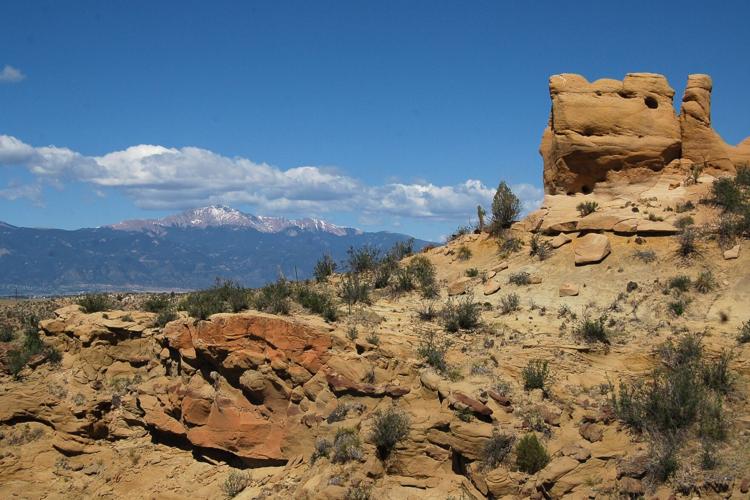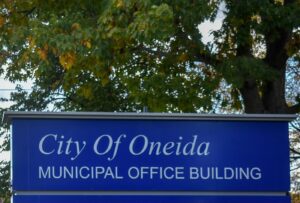
Visitors to Colorado Springs can now explore the ancient wonders of Corral Bluffs through new ranger-led tours. The initiative, launched this summer, aims to share the rich geological and paleontological history of the area with the public. City park ranger Mike Bowman guides participants through the rugged terrain, revealing significant findings from the region that dates back millions of years.
The tours take place in a scenic environment, walking through a corridor formed by grasslands and rock walls, where canyons and hoodoos create a striking backdrop. Corral Bluffs is particularly noted for its location along the K-T Boundary, the geological layer marking the transition from the age of dinosaurs to the rise of mammals approximately 66 million years ago. This historical significance has captured the attention of scientists and the general public alike.
During the excursion, Bowman highlights various fossils and geological features. “That’s palm wood right there,” he points out, indicating a remnant of what was once a tropical forest. The area has yielded fossils of early mammals, including Loxolophus, a raccoon-sized creature that roamed the land during this transformative period in Earth’s history.
The tours are scheduled for Fridays and Saturdays, allowing eager participants to reserve spots through the city’s official website, coloradosprings.gov/corralbluffs. These ranger-led events complement ongoing efforts by the Corral Bluffs Alliance and dedicated volunteers like Paula Watkins, who has expressed her enthusiasm for the continued exploration of this “gem” located just outside city limits.
The importance of Corral Bluffs is underscored by its designation as a vital archaeological site. Matt Mayberry, the city’s cultural services manager, referred to Corral Bluffs as a “bookend” to the famous Garden of the Gods, another iconic natural landmark in the area. He noted that while Garden of the Gods attracts numerous visitors, Corral Bluffs has remained relatively undiscovered until now, largely due to its gated access since the city’s acquisition in 2008.
The acquisition was a significant relief for advocates who feared the land could be developed for other uses, such as a dirt bike park. Mayberry pointed out that there was a strong belief that important discoveries would emerge from Corral Bluffs, and the subsequent findings have validated that expectation.
One pivotal moment in this ongoing exploration occurred on September 10, 2016, when paleontologist Tyler Lyson discovered the skull of a carsioptychus while cracking open a rock. This discovery, along with others, was later showcased in an exhibit titled “After the Asteroid: Earth’s Comeback Story” at the Denver Museum of Nature and Science.
The excitement surrounding Corral Bluffs continues to grow, with new species being documented. Recent findings include the eoconodon, a mammal about the size of a wolf, and Militocodon lydae, resembling a chinchilla. These discoveries not only enhance the area’s historical significance but also generate interest in its potential as a recreational and educational site.
While the guided tours are a step forward, the broader opening of Corral Bluffs to the public remains uncertain. City Parks Director Britt Haley acknowledged that economic circumstances have slowed progress. “As much as I have wanted to be able to move the process forward, economic circumstances have not allowed that,” she stated, emphasizing the city’s commitment to responsible management of the site.
Before any master plan can be implemented for broader access, the city aims to acquire additional surrounding land to connect Corral Bluffs with another significant archaeological site, Jimmy Camp Creek Park. This park has revealed evidence of human presence dating back 3,500 years, with some estimates suggesting habitation as far back as 8,000 years.
By managing Corral Bluffs and Jimmy Camp Creek Park as a single scientific and cultural landscape, city officials hope to preserve the unique heritage of the region. The potential for development in the area, particularly through plans by Norwood Development Group for an expanded Banning Lewis Ranch, has raised concerns among advocates for responsible stewardship.
Watkins voiced her worries about the impact of increased residential development on the delicate ecosystem. Advocates and city officials alike are weighing the benefits of increased public access against the need for conservation. The prospect of a status similar to that of the Florissant Fossil Beds National Monument has been discussed, though some maintain that local control is preferable.
Both Haley and Mayberry emphasize the uniqueness of the area, hoping visitors will recognize the significance of Corral Bluffs in a manner akin to their experience at Garden of the Gods. “To have that pride of place, that’s what I want people to take from it,” Haley remarked.
As the ranger-led tours continue, Bowman remains optimistic about the future of Corral Bluffs. “With more inspection, it’s easy to imagine more fossils meeting daylight,” he noted, reflecting the ongoing potential for discovery in this remarkable region.







